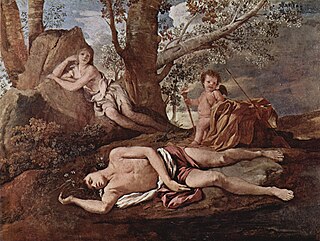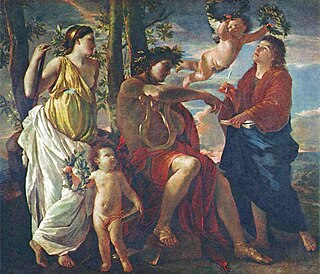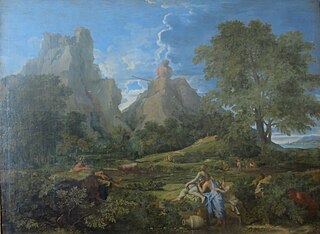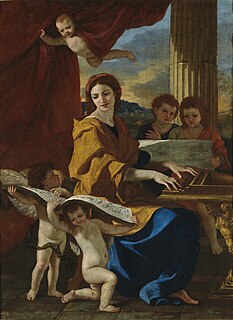 W
WNicolas Poussin was the leading painter of the classical French Baroque style, although he spent most of his working life in Rome. Most of his works were on religious and mythological subjects painted for a small group of Italian and French collectors. He returned to Paris for a brief period to serve as First Painter to the King under Louis XIII and Cardinal Richelieu, but soon returned to Rome and resumed his more traditional themes. In his later years he gave growing prominence to the landscapes in his pictures. His work is characterized by clarity, logic, and order, and favors line over color. Until the 20th century he remained a major inspiration for such classically-oriented artists as Jacques-Louis David, Jean-Auguste-Dominique Ingres and Paul Cézanne.
 W
WThe Adoration of the Golden Calf is a painting by Nicolas Poussin, produced between 1633 and 1634. It depicts the adoration of the golden calf by the Israelites, from chapter 32 of the Book of Exodus. It was made as part of a pair of paintings commissioned by Amadeo dal Pozzo, Marchese di Voghera of Turin, a cousin to Cassiano dal Pozzo, Poussin's main sponsor in Rome. By 1685 the pair had passed to the Chevalier de Lorraine and in 1710 they were bought by Benigne de Ragois de Bretonvillers. In 1741 they were bought from Samuel by Sir Jacob Bouverie, whose son William became the first Earl of Radnor. The Earls of Radnor owned the pair from then until 1945, when it was split for the first time and The Adoration of the Golden Calf bought by the National Gallery in London for £10,000, half of which was contributed by the Art Fund. It now hangs in Room 19 of the National Gallery, where it and Poussin's The Adoration of the Shepherds were vandalised with red spray paint on 17 July 2011. The French-speaking vandal covered up most of the nude figures.
 W
WThe Adoration of the Shepherds is a painting of 1633–34 by the French painter Nicolas Poussin (1594–1665), now in the National Gallery, London. It is in oils on canvas, and measures 97.2 by 74 centimetres. Unusually for Poussin, it is signed "N. Pusin.fe" ["fecit"] on the stone at lower right. By 1637, soon after it was painted, it was owned by Cardinal Gian Carlo de' Medici (1611–1663), the second son of Grand Duke Cosimo II of Tuscany and was placed in his villa outside Florence.
 W
WBlind Orion Searching for the Rising Sun is a mid 17th-century painting by French artist Nicolas Poussin. Done in oil on canvas, the paintings depicts a scene in which the mythological figure Orion - having been blinded - searches for the rising sun. The painting's scene was inspired by the Assyrian writer Lucian's writings on Greek mythology, including the Orion legend. Poussin painted Blind Orion on behalf of Michel Passart, a well-known patron of landscape painting. Poussin's work is in the collection of the Metropolitan Museum of Art, which considers the work to be one of Poussin's greatest landscape painting.
 W
WThe Crossing of the Red Sea is a painting by Nicolas Poussin, produced between 1633 and 1634. It depicts the crossing of the Red Sea by the Israelites, from chapter 14 of the book of Exodus. It was made as part of a pair of paintings commissioned by Amadeo dal Pozzo, Marchese di Voghera of Turin, a cousin to Cassiano dal Pozzo, Poussin's main sponsor in Rome. By 1685 the pair had passed to the Chevalier de Lorraine and in 1710 they were bought by Benigne de Ragois de Bretonvillers.
 W
WA Dance to the Music of Time is a painting by Nicolas Poussin in the Wallace Collection in London. It was painted between about 1634 and 1636 as a commission for Giulio Rospigliosi, who according to Gian Pietro Bellori dictated its detailed iconography. The identity of the figures remains uncertain, with differing accounts.
 W
WThe Death of Chione is a 1622 painting by Nicolas Poussin, his first known surviving work. He produced it during a stay in Lyon and in February 2016 it was acquired by that city's Museum of Fine Arts. It shows the death of Chione, lover of both Hermes and Apollo - she had compared her beauty to that of Apollo's sister Artemis, who hunted her down and killed her by shooting an arrow through her tongue.
 W
WEcho and Narcissus is an oil painting of 1627 and 1628 by French artist Nicolas Poussin. It measures 74 by 100 cm and is kept in the Louvre, Paris.
 W
WEt in Arcadia ego is a 1637–38 painting by Nicolas Poussin (1594–1665), the leading painter of the classical French Baroque style. It depicts a pastoral scene with idealized shepherds from classical antiquity, and a woman, possibly a shepherdess, gathered around an austere tomb. It is held in the Louvre.
 W
WExtreme Unction is one of a set of seven scenes representing the sacraments of the Catholic Church, painted between 1638 and 1640 by the French artist Nicolas Poussin (1594–1665).
 W
WThe Flight into Egypt is a painting by Nicolas Poussin painted in 1657 or 1658. It was originally kept in the Musée du Louvre, then was transferred to the Musée des Beaux-Arts de Lyon.
 W
WThe Four Seasons was the last set of four oil paintings completed by the French painter Nicolas Poussin (1594–1665). The set was painted in Rome between 1660 and 1664 for the Duc de Richelieu, the nephew of Cardinal Richelieu. Each painting is an elegiac landscape with Old Testament figures conveying the different seasons and times of the day. Executed when the artist was in failing health suffering from a tremor in his hands, the Seasons are a philosophical reflection on the order in the natural world. The iconography evokes not only the Christian themes of death and resurrection but also the pagan imagery of classical antiquity: the poetic worlds of Milton's Paradise Lost and Virgil's Georgics. The paintings currently hang in a room on their own in the Louvre in Paris.By his absolute humility, by his effacement of himself, by his refusal to use any tricks or overstate himself, Poussin has succeeded in identifying himself with nature, conceived as a manifestation of the divine reason. The Seasons are among the supreme examples of pantheistic landscape painting.Jamais peut-être, dans toute la peinture occidentale, des choses aussi nombreuses et parfois si difficiles n'avaient été dites avec une telle simplicité. Jamais un peintre ne s'était aussi pleinement identifié à l'ordre du monde. Mais cette identification n'est ni « une projection » ni une confidence : là est le sens de cette impersonalité que l'on a pu reprocher à Poussin, et qui fait sa grandeur.
 W
WThe Funeral of Phocion is a 1648 landscape painting, also known as The Burial of Phocion, Landscape with the Funeral of Phocion and Landscape with the Body of Phocion Carried out of Athens, by the French artist Nicolas Poussin. Phocion was an Athenian statesman from the 4th century BC.
 W
WThe Inspiration of the Poet is an oil-on-canvas in the classical style by the artist Nicolas Poussin, painted between 1629 and 1630. It is currently held and exhibited at the Louvre in Paris.
 W
WLandscape with Orpheus and Eurydice is a 200 × 124 cm oil-on-canvas by artist in the classical style Nicolas Poussin, painted between 1650 and 1653. It is currently held and exhibited at the Louvre in Paris
 W
WLandscape with Polyphemus is a 1649 oil painting by French artist Nicolas Poussin.
 W
WLandscape with the Ashes of Phocion is a 1648 painting, also known as Landscape with the Ashes of Phocion and The Ashes of Phocion Collected by his Widow, by French artist Nicolas Poussin. Phocion was an Athenian statesman from the 4th century BC.
 W
WLandscape with Three Figures is a c.1645-1650 oil on canvas painting by Nicolas Poussin, now in the Prado Museum in Madrid. Poussin moved to landscape late in life.
 W
WLandscape with Two Nymphs is a c.1659 painting by Nicolas Poussin. A late work, it seems to have been painted for Charles Le Brun, another painter. It was sold from the Radziwiłł collection in 1866 to Frédéric Reiset, a curator at the Louvre. Reiset sold it with the rest of his collection to Henri d'Orleans, Duke of Aumale in 1879 and so the work is now in the Musée Condé in Chantilly
 W
WThe Massacre of the Innocents is a 1625-1632 painting by Nicolas Poussin, showing the Massacre of the Innocents. It was probably commissioned by the Roman collector Vincenzo Giustiniani, probably in memory of the tragic fate of the Giustiniani children taken hostage by the Ottoman Empire in 1564. It remained in the Palazzo Giustiniani until 1804, when it was bought by Lucien Bonaparte. It then passed through several other hands before being bought in London by Henri d'Orleans, Duke of Aumale. It is now in the Musée Condé in Chantilly, France.
 W
WParnassus or Apollo and the Muses is a 1631-1633 painting by Nicolas Poussin, inspired by Raphael's Parnassus in the Stanza della Segnatura and now in the Prado Museum in Madrid. It was first mentioned in Spain in a 1746 inventory of the La Granja de San Ildefonso palace.
 W
WThe Plague of Ashdod is also known as The Miracle of the Ark in the Temple of Dagon, by the French artist Nicolas Poussin. The painting represents a story from 1 Samuel in the Old Testament. The original painting currently hangs in the Louvre in Paris. Poussin was commissioned to paint The Plague of Ashdod by Fabrizio Valguarnera. Fabrizio Valguarnera was a Sicilian merchant who was put on trial for laundering money through the purchase of this painting; he also commissioned more than one version of this piece. Poussin painted this during a plague that took place in Italy from 1629 to 1631, which influenced his accurate portrayal of the epidemic.
 W
WSaint Cecilia is a 1627–1628 painting by Nicolas Poussin, now in the Prado Museum in Madrid. It shows saint Cecilia playing a keyboard instrument, possibly a harpsichord. Two cherubs in front of her hold up a scroll with a musical score, whilst two angels sing in the background and a third cherub lifts a curtain.
 W
WThe Seven Sacraments refers to two series of paintings of the seven sacraments by the French painter Nicholas Poussin.
 W
WSleeping Venus with Cupid is an oil on canvas painting by the French artist Nicolas Poussin. It was completed in 1630 and is now part of the collection of the Gemäldegalerie Alte Meister in Dresden, Germany.
 W
WThe Death of Germanicus is a painting made in 1627 by Nicolas Poussin for Francesco Barberini. It is kept at the Minneapolis Institute of Art.
 W
WThe Martyrdom of Saint Erasmus is an altarpiece, painted by Nicolas Poussin in 1628-1629, originally displayed in St. Peter's Basilica, Rome.
 W
WTheseus Rediscovering His Father's Sword is a c.1638 painting by Nicolas Poussin and Jean Le Maire, acquired in London by Henri d'Orléans, Duke of Aumale in 1860, moved to his château de Chantilly in 1871 and now in the Musée Condé at Chantilly. The Uffizi and the Wildenstein collection hold autograph copies of the work, but X-ray examination has shown much retouching of the Chantilly version and so it is accepted as the original of the composition.
 W
WVenus and Adonis or View of Grottaferrata with Venus, Adonis and a River Divinity is a c.1626 painting by Nicolas Poussin, now in the Musée Fabre in Montpellier.
 W
WVenus Weeping for Adonis is a c.1625 oil on canvas painting by the French painter Nicolas Poussin. Painted after his relocation to Italy it is now part of the collection of the Musée des Beaux-Arts de Caen.